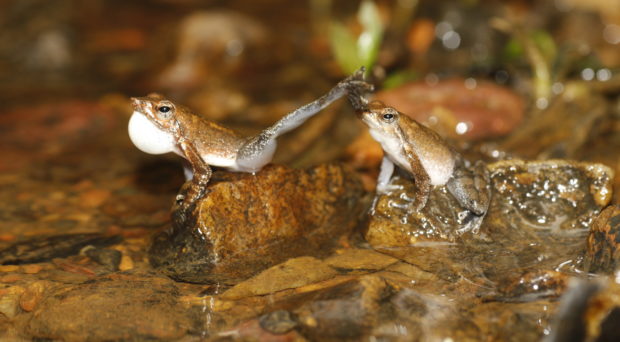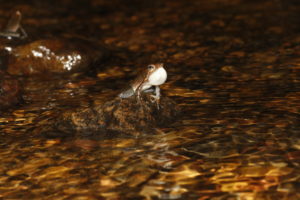
When I saw a foot-flagging frog (a frog that waves his hind legs to show colored foot webbings) for the first time, I was standing on top of a waterfall in Borneo. I yelled out to my colleague: “they are down there” but he could not understand me, so I started signaling with my hands (look-down there). At this moment it became pretty clear why sound is often not enough to communicate in noisy environments, and for the rest of the day both of us watched male foot-flagging frogs defending their perching sites with acoustic and visual signals.
Environmental noise is of course not constricted to rushing water; a lot comes from other animals, for examples cicadas that sing to find a mate or other frog species that advertise to attract females and to repel rivals. Most of this noise is restricted to certain time periods or a certain frequency and frogs are experts in avoiding signal overlaps. However individuals of the same species have equal activity times, more or less the same call frequency, and like males of an Indian foot-flagging frog call from stones in noisy streams, which makes it difficult to detect your rivals.
But why signal in noisy environments in the first place? In the case of foot-flagging frogs, almost all species worldwide live and more importantly breed in fast-flowing stream habitats. The streams are visited by gravid females. Males perch along the stream and attend choruses; thereby increasing their chance to attract a mate. To deal with noise, they use additional visual modalities for communication.
A second signal modality

The approximately 2 cm large (or rather small) males of the Indian foot-flagging frog species inflate a bright white vocal sac while calling. And although their body coloration can vary from yellow, reddish or dark brown they are always very well camouflaged in their environment. Only while calling, when the white vocal sac flashes periodically or while foot-flagging and displaying silver foot-webbings, can one immediately visually detect them. The vocal sac did not evolve as a visual cue per se, but rather as an organ that recycles air while calling. This made us curious and we wanted to test if males are influenced by the visual signal of the pulsating vocal sac or rather react to only the calls of conspecifics.
So we used two plastic boxes that were glued on top of each other, the bottom was sunk in the stream and the on the top box we affixed the tip of a rubber glove connected to a tube we could manually inflate from a distance. Behind the top box we put a loudspeaker. We then played back only calls from a distance of 50 cm to a frog and later we tested the reaction of individual males to calls and the flashing rubber balloon. For our results we only used reactions displayed for a standardized period of 4 minutes after play back presentations. Just out of interest, we kept on playing multimodal presentations in some trials and some frogs did not get tired to compete with the rubber balloon mimicking the white vocal sac with accompanying call stimuli.
Our results suggested that visual signals of an inflating vocal sac are used to locate and detect the opponent and elicit more and longer calls and more visual signal activity in males than play-back calls alone. Interestingly, the tested males only displayed foot-flagging behavior in response to acoustic and visual stimuli. Thereby males that detected an opponent (in our case: calls from a loudspeaker and synchronously inflating balloon) in close vicinity immediately started advertising and signaled threat displays.
Foot-flagging behavior
Unlike the common assumption that foot-flagging frogs wave their legs and show their colored webbings to attract females, the influence of foot-flags on females has never been tested. Foot flagging is mainly used as an agonistic or threat signal towards rivals and most likely originates from a kicking behavior to kick the opponent off its perching site and claim the territory. Exaggerations of limb lifting and stereotype movement patterns causing a behavioral change in opponents could have triggered the ritualization of the conspicuous foot-flagging behavior.
The threat signals are also used by juveniles of a Bornean species during feeding in the Vienna Zoo presumably to defend food resources. Our recent investigations showed that androgenic hormones mediate the behavior and androgen receptors in the hind limb musculature are expressed at levels 10x greater than in two other anuran species that do not produce foot signals.
Whenever you ask somebody how frogs communicate, the answer will be: “ribbit ribbit”! Vocalizations are the most conspicuous displays to human observers and as a consequence other signal modalities have traditionally received less attention. However over the past decades we have realized that colors and movements fulfill communicative functions and help frogs to deal with biotic and abiotic noise, an important accessory in an increasingly noisy world.
Read full journal article: Multimodal signaling in the Small Torrent Frog (Micrixalus saxicola) in a complex acoustic environment
Doris Preininger
Latest posts by Doris Preininger (see all)
- Signaling in noisy environments - 8th September 2016